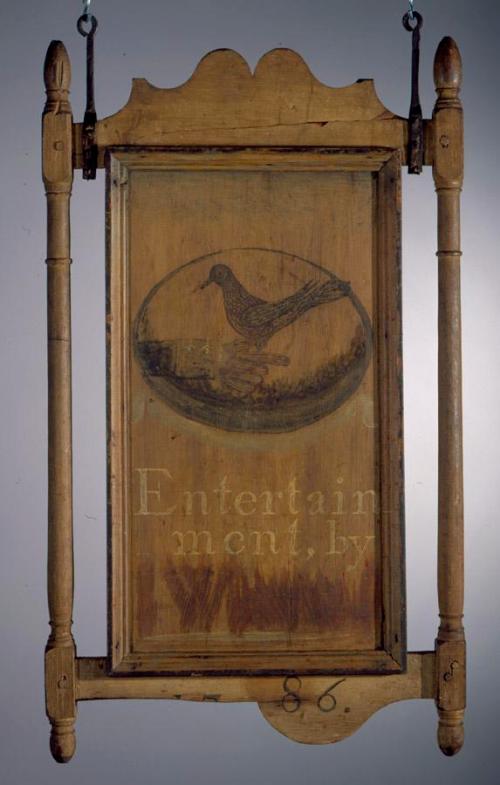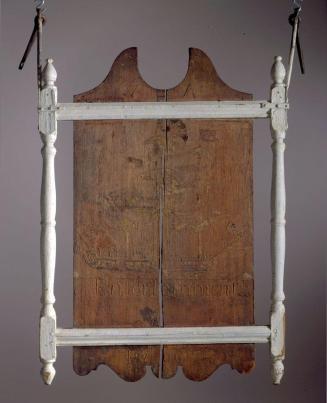Sign of the Bird-in-Hand
MakerMade by
Unknown
Date1786
MediumPaint on pine board, pine rails and moldings, chestnut posts, iron hardware
DimensionsPrimary Dimensions (height x width including hardware): 49 x 27 3/4in. (124.5 x 70.5cm)
Other (height x width of sign only): 47 1/4 x 27 3/4in. (120 x 70.5cm)
ClassificationsPainting
Credit LineCollection of Morgan B. Brainard. Gift of Mrs. Morgan B. Brainard
Object number1961.63.6
DescriptionImages: On both sides, a gloved hand holding a bird, framed within an oval outline, centered on a Prussian Blue background (now faded nearly to white); no underlying images.
Construction: Single board; flat, shaped rails; turned posts. Board is set vertically and tenoned into top and bottom rails. The rails have integral pediment and skirt (e.g., vertical extensions, which are hand-sawn to create decorative profiles). Rails are tenoned horizontally through the turned posts, with some of these joints wedged in addition to being pinned. Decorative moldings, mitered at the corners, are nailed to both faces of the signboard. The sign frame employs an extended baluster shape for the posts, rather than bisymmetrical balusters flanking a central ring, which is the more common 18th-century treatment. A little ring, or "collerina," punctuates the long neck of the baluster. Wood used in the turned posts is Castanea dentata, American chestnut, identified by analysis (Hoadley, March 2000).
Surface: This sign displays only one layer of paint on each side. The oval image area was originally executed in dark red, blue-green, black, and white. Traces of blue paint visible at the signboard edges were sampled and determined by FTIR and PLM analysis to contain Prussian blue pigment; a sample from the green-colored area of the oval vignette contained a very small amount of Prussian blue, resulting in the green hue still visible. The name of the tavern owner was removed mechanically using some sort of small blade; guidelines scribed into the wood for the height of the letters remain visible. The scalloped oval border around the central vignette seems to have been laid out with a pattern, which evidently shifted in process (like the misaligned bird-in-hand).
Construction: Single board; flat, shaped rails; turned posts. Board is set vertically and tenoned into top and bottom rails. The rails have integral pediment and skirt (e.g., vertical extensions, which are hand-sawn to create decorative profiles). Rails are tenoned horizontally through the turned posts, with some of these joints wedged in addition to being pinned. Decorative moldings, mitered at the corners, are nailed to both faces of the signboard. The sign frame employs an extended baluster shape for the posts, rather than bisymmetrical balusters flanking a central ring, which is the more common 18th-century treatment. A little ring, or "collerina," punctuates the long neck of the baluster. Wood used in the turned posts is Castanea dentata, American chestnut, identified by analysis (Hoadley, March 2000).
Surface: This sign displays only one layer of paint on each side. The oval image area was originally executed in dark red, blue-green, black, and white. Traces of blue paint visible at the signboard edges were sampled and determined by FTIR and PLM analysis to contain Prussian blue pigment; a sample from the green-colored area of the oval vignette contained a very small amount of Prussian blue, resulting in the green hue still visible. The name of the tavern owner was removed mechanically using some sort of small blade; guidelines scribed into the wood for the height of the letters remain visible. The scalloped oval border around the central vignette seems to have been laid out with a pattern, which evidently shifted in process (like the misaligned bird-in-hand).
Collections
Label TextThe ‘bird-in-hand’ was a common tavern sign motif in both North America and England. Extolling the advantages of present, known circumstances over future, unrealized possibilities may have also encouraged travelers to stop while they had the chance, not unlike modern “last stop for gas” signs.
Status
On viewCaptain Aaron Bissell Sr.
1772-1786












